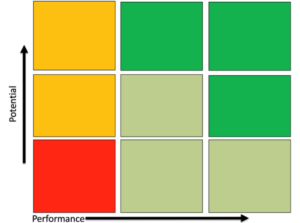 Written for EO by Gareth Williams, founder of YellowDog.
Written for EO by Gareth Williams, founder of YellowDog.
When you launch a business on your own, you don’t need to worry about anyone’s performance apart from your own. As your business grows, you recruit talent to work with you. You make key hires and start building your team. But that’s just the beginning.
How do you assess how your new team members are performing without relying solely on KPIs? How can you develop the right personal development plans for your people? How can you be confident that when you’re delegating responsibility, it is to the right person? How can you be sure that they are ready to rise to the challenge?
I’m the founder and CEO of YellowDog. We use a Talent Grid to help us answer exactly these kinds of questions.
Read on to learn what a Talent Grid is, how you can use it to empower your team, and why every early-stage business should use the grid to be successful.
What Is a Talent Grid?
A 9 Box Talent Grid looks like this:

There are variations but, on the whole, a 9 Box Talent Grid has performance on one axis and potential on another. You map both your people and your teams on it. Performance is quantitative: You can define it based on results. Potential is subjective—and this is where a management team tracking their people with a Talent Grid becomes very useful. It helps you create personal development plans and develop your business in the right way.
How to Use a Talent Grid for Personal Development Plans
The color codes are intuitive: green is good; everything is great. But a team member who’s in the red or on the far left side of the grid has performance issues. Those issues may stem from being new in the role. Or maybe there’s something else going on in his or her private life that is affecting them. Whatever color your team member is performing in, you have to consider how it relates to their potential. Otherwise, it’s impossible to know how to help them develop.
In our sales team, we have recently delegated ownership of a few key projects to one of our “top-right” individuals. The person has been performing well: closing sales, adapting their approach to win new business and developing lasting partnerships with key customers. Now, we are challenging the team member to figure out how to maximize return from high-value customers in a complex and strategic sale. We’ve effectively said, that’s yours!
Retaining people like this, who are in the top right of your 9 Box Grid Model, is a top priority. We employ high-leverage practices to keep them engaged and challenged—including connecting with a mentor outside of our business. Mentorship can help a person to grow in ways they wouldn’t otherwise, so long as both the mentor and mentee approach it in the right way.
Using a Talent Grid to Manage People on an Exit Path
On the other side of the Talent Grid, it’s a very different development plan. We review the Talent Grid every month as a management team and look at how people are moving. We ask questions like: “Should we be concerned about them? What are we doing to help people move to the right of the grid?”
If someone in your team is in the bottom left, then someone is on an exit path. If you identify an employee in that position, then you need to spend more time with that person. It’s time to create a development plan that is more directional. You create a path focused on helping the individual function better in his or her role.
Behaviors are important when people find themselves in the bottom left. When people are struggling, we focus less on what they’re doing and more on how they’re doing it.
We’ve helped people move off of an exit path a handful of times at YellowDog. In a high growth business, it’s particularly tough because everyone’s time is precious. But when you see a member of your team moving steadily toward the right side of the grid, you know that the time you’ve invested in them was worth it. As for their development plan…well…it develops with them at that point.
All Businesses Need a Talent Grid
The largest team I’ve run comprised 120 people, and we still used a Talent Grid. You can’t map hundreds of employees on a Talent Grid, but you can map direct reports and their direct reports on the grid. Those direct reports should create and manage their own talent management grid.
Do you always need everyone and everything to be in the top right? Not necessarily.
If you’re running a well-established business you don’t need many high-performance, high-potential people. Actually, you may want a large portion of the workforce to be functional in the machine. You may just want lots of employees in position to turn the handle.
For example, you don’t want someone in a large organization processing invoices who is high-performance and high-potential. Inevitably, that person will grow bored and leave. You also don’t want to push someone who loves processing invoices and is good at it, into a role that requires him or her to think too creatively. This person will become stressed and leave.
Mapping and tracking every person is important no matter what industry you’re in. It’s part of developing a company culture that engages the right employees.
Read more from Octane on how to build your A-team and empower your employees.
Why High-Growth Businesses Need People in the Top Right
In an early-stage business like YellowDog, you obviously need a mix of skills. In your ideal world, unlike many large businesses, you need as many people as possible functioning in the top-right corner of the 9 Box Talent Grid.
You want people who perform highly but have the potential to grow with you. They will adapt and change with you. This usually also means that because they are high potential, they are comfortable soaking up pressure and elements of risk. These traits are essential for them—and your early stage business—to thrive.
Giving Ownership to People in the Top Right
If you trust someone and they are in the top right of the Talent Grid, you need to let go if you want the business to grow.
The hardest aspect of letting go is knowing that you can do that task quicker—and possibly better, with fewer mistakes. I navigated that process years ago, earlier in my career and went from a “doer” to a “reviewer,” and that’s where a CEO should be.
Right now, I’m still transitioning between doing and reviewing again. I’m more hands on than a typical CEO because we’re growing so quickly and I’m still close to many aspects of the business. The only way that you can be less hands on is if you let go of what you love without losing control of it. I am perfectly happy with that.
How to let go and delegate
Delegate softly. Do it gently. You’ll scare people if you give them a pen and a blank piece of paper and say, “This is yours! Map it out and make it happen.” Look back as you walk away, and you’ll see the look of terror on their faces!
There’s a balance to strike. If you give people too much space, they will get overwhelmed. They won’t explore whatever project you’ve given them with the freedom that’s required. By setting a few boundaries, you give them confidence and security.
In a playground experiment, it was found that children in a yard with no fence will huddle around the teacher. Put a fence up around the outside of the playground and you’ll see the kids running around and enjoying the space. It is the same with work. In business, though, the playground fence is a budget, a timeframe or a result. Your people will explore the space when you provide a few boundaries.
Delegate large projects by breaking them up
Delegating, even for those in the top right who are performing with potential, is hard. When you trust someone enough to give them ownership of a critical project, begin by chunking it down. There’s an episode in “CSI: Crime Scene Investigation” where Grissom is asked by Warrick Brown how they should handle something. His reply is: “Same way you’d eat an elephant—one bit at a time.” The tools our development team uses to break up projects and share responsibility include Scrum and Kanban.
Using the Talent Grid for an Outsourced Team
A lot of our development at YellowDog is done with a remote team. We use a talent management grid with them too. After all, it’s best to view your team as united, not divided by local and remote.
To get a remote team working well, begin by over-investing your time. Over-communicate what you’re doing and why. Meet them face to face, get to know them.
We recruit and manage our remote team in exactly the same way as if they were our local team.
The first step to getting your remote team working well on a large project is selecting your lieutenant. That first person you recruit is your voice, not the remote team’s voice. Together, you build a team from that partnership. Together, you recruit. Together, you map and track people on your talent grid.
Those big projects that you have delegated to a remote team soon become manageable pieces that are distributed out to the right people at the right time. Again, with Scrum and Kanban, we have found we can maintain control without restricting the freedom of the team.
Value-Based Recruitment
Recruiting a quality team is a massive challenge. We select people who show competency in the demands of the role and, more importantly, who display our values.
YellowDog’s values came about right before our launch with me sitting in a room, thinking about it, and writing down what came to mind. And then I went on a bike ride to clear my head. When I came back to the room and looked at what I had written, the values still felt right. Our values haven’t changed despite the growth and adaptation of the business to our markets. I’m proud of that.
Our values are: hard working, trustworthy, reliable, loveable, friendly, fun loving, and adventurous.
Recruiting based on your business’ values goes back to the importance of behaviors.
The reality is that until people join our team, we’ll never really know where they will sit on our 9 Box Talent Grid—truly how much potential they have and how they will perform. And, even then, people change over time.
Value-based recruitment gives the team behavioral resilience in times of change and growth.
Using a 9 Box Talent Grid to Scale your Business
The talent grid model helps us keep our talented people and maximize their potential in return for tangible results. Recruiting well is the first step to building a great team. Visually tracking the team using a talent grid helps us as managers to analyze what’s really going on in the business. It gives me confidence that we are developing and retaining key team members in key areas of the business.
I know when and where we can delegate to the right people. I know that those people will help take our growth to the next level, and that’s very exciting—for me, for them and for us.
Categories: LEADERSHIP

